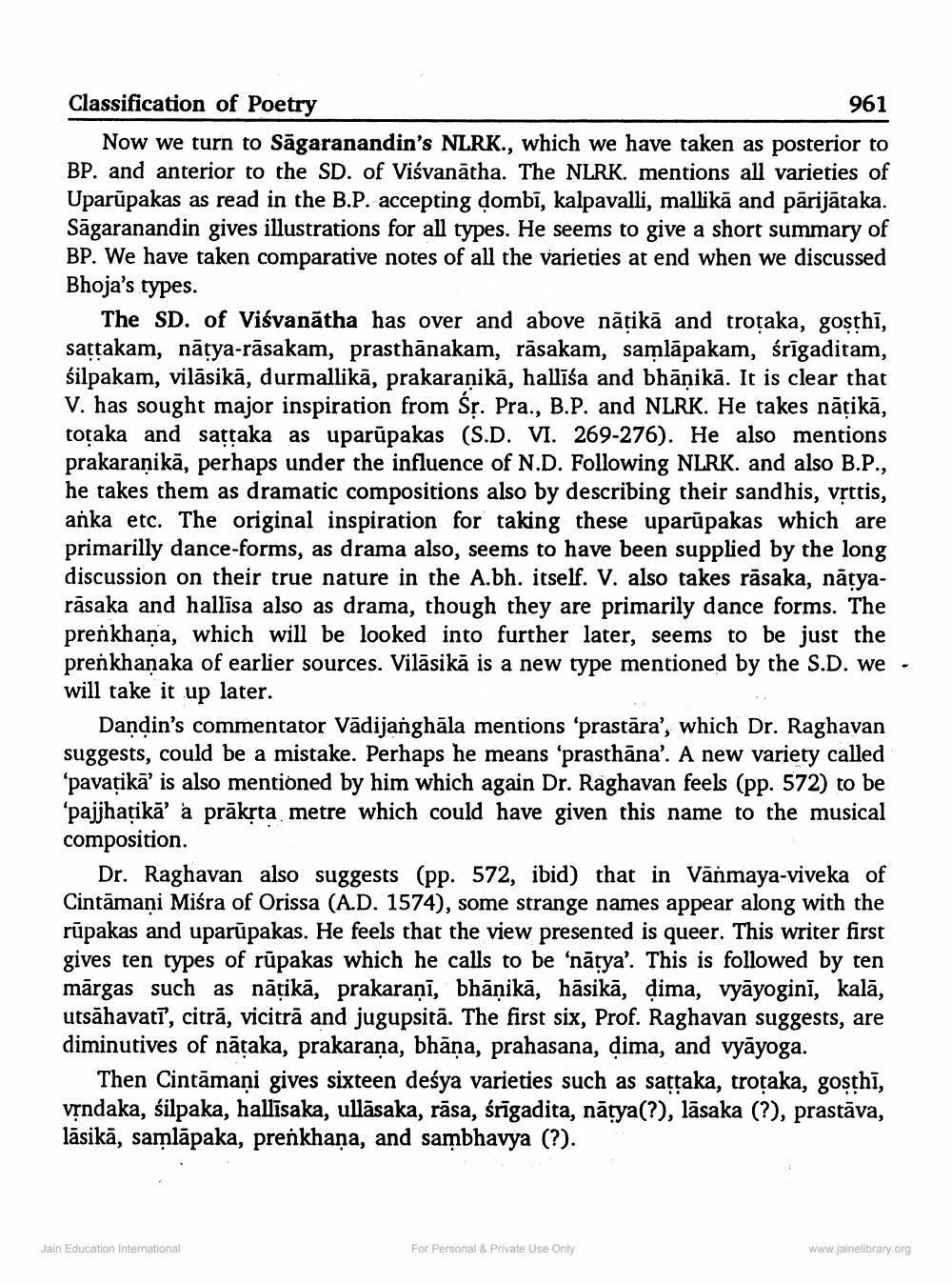________________
Classification of Poetry
961
Now we turn to Sāgaranandin's NLRK., which we have taken as posterior to BP. and anterior to the SD. of Viśvanatha. The NLRK. mentions all varieties of Uparūpakas as read in the B.P. accepting dombī, kalpavalli, mallikā and pārijātaka. Sāgaranandin gives illustrations for all types. He seems to give a short summary of BP. We have taken comparative notes of all the varieties at end when we discussed Bhoja's types.
The SD. of Viśvanatha has over and above nāțikā and trotaka, gosthi, saṭṭakam, nātya-rāsakam, prasthānakam, rāsakam, samlāpakam, śrīgaditam, śilpakam, vilāsikā, durmallikā, prakaraṇikā, hallīśa and bhāņikā. It is clear that V. has sought major inspiration from Śr. Pra., B.P. and NLRK. He takes nāṭikā, totaka and saṭṭaka as uparūpakas (S.D. VI. 269-276). He also mentions prakaraṇikā, perhaps under the influence of N.D. Following NLRK. and also B.P., he takes them as dramatic compositions also by describing their sandhis, vṛttis, anka etc. The original inspiration for taking these uparūpakas which are primarilly dance-forms, as drama also, seems to have been supplied by the long discussion on their true nature in the A.bh. itself. V. also takes rāsaka, natyarāsaka and hallīsa also as drama, though they are primarily dance forms. The prenkhana, which will be looked into further later, seems to be just the prenkhanaka of earlier sources. Vilasika is a new type mentioned by the S.D. we . will take it up later.
Dandin's commentator Vādijanghala mentions 'prastara', which Dr. Raghavan suggests, could be a mistake. Perhaps he means 'prasthāna'. A new variety called 'pavatika' is also mentioned by him which again Dr. Raghavan feels (pp. 572) to be 'pajjhaṭikā' a prākṛta metre which could have given this name to the musical composition.
Dr. Raghavan also suggests (pp. 572, ibid) that in Vanmaya-viveka of Cintamani Miśra of Orissa (A.D. 1574), some strange names appear along with the rūpakas and uparūpakas. He feels that the view presented is queer. This writer first gives ten types of rūpakas which he calls to be 'natya'. This is followed by ten mārgas such as nāțikā, prakaraṇī, bhāṇikā, hāsikā, ḍima, vyāyoginī, kalā, utsähavati', citrā, vicitra and jugupsita. The first six, Prof. Raghavan suggests, are diminutives of nataka, prakaraṇa, bhāṇa, prahasana, dima, and vyāyoga.
Then Cintamani gives sixteen deśya varieties such as saṭṭaka, troṭaka, gosthi, vṛndaka, śilpaka, hallīsaka, ullāsaka, rāsa, śrīgadita, nāṭya(?), lāsaka (?), prastāva, lāsikā, samlāpaka, preńkhaṇa, and sambhavya (?).
Jain Education International
For Personal & Private Use Only
www.jainelibrary.org




